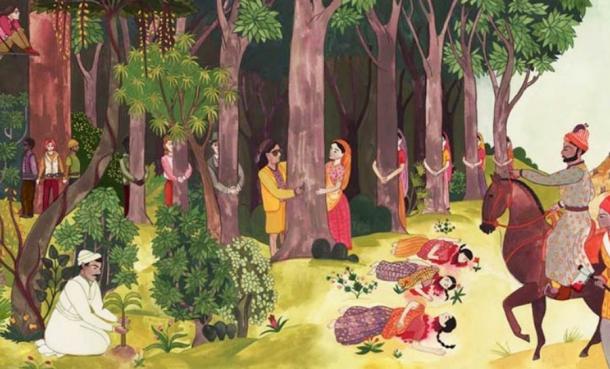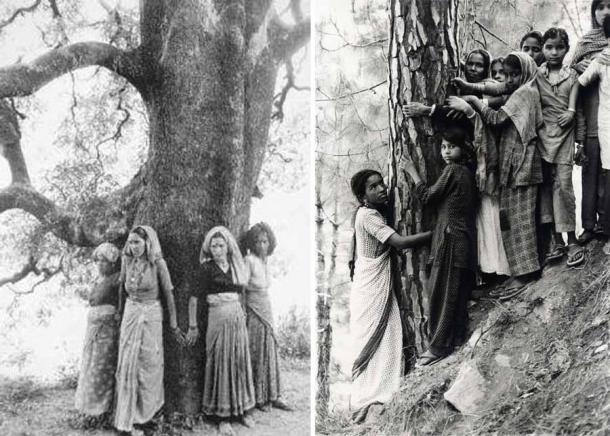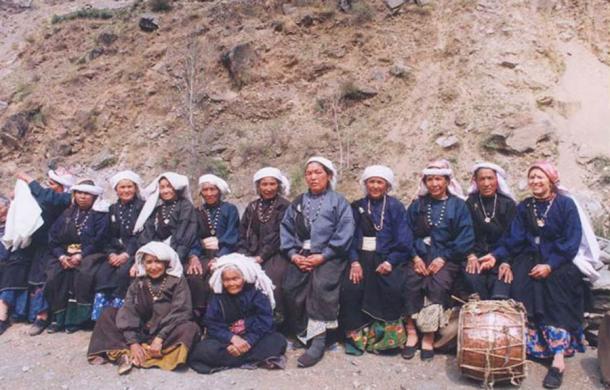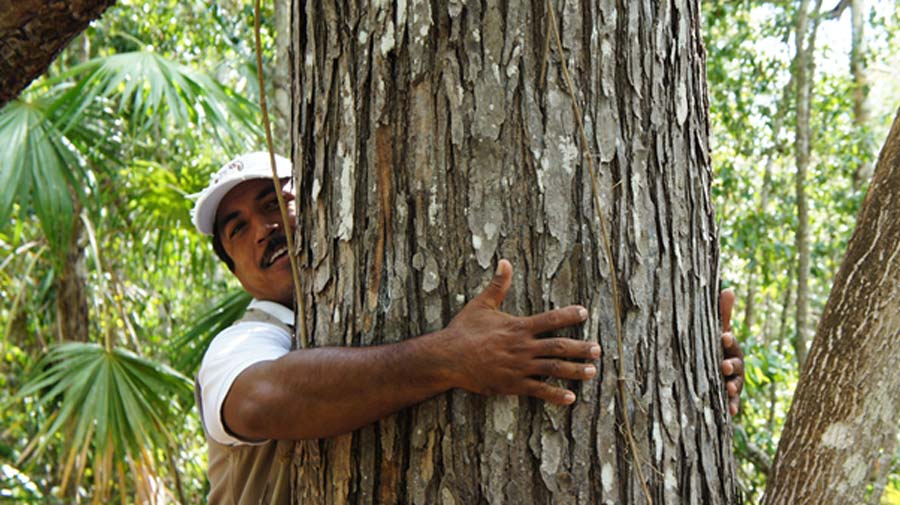Tree Huggers. The Unspoken History of Indian Environmental Martyrs
The term "tree hugger" is a phrase greatly associated with 1970's era Western liberal activists vigilantly trying to protect the environment from humanity's industrial destructive thirst for profit.
But this romantic view of tree huggers, as activist journalist and photographer Michael A. Estrada discusses, pales with the term’s untold origins. Tree hugging is an act that has been practiced over hundreds of years by people around the world. The first recorded case was in 1730 with the Bishnoi people in the Khejarli massacre. The second, more recent and much more influential, was the Chipko movement from the Himalayas in 1970.
These two acts of conflict were the most historically significant events that quietly inspired feminist activism and environmental justice movements throughout the Western world. Yet, the significance of these two events (Khejarli massacre; Chipko movement) were underplayed and largely ignored, most likely due to a subtle discriminating racial bias.
Due to this unfortunate reality, awareness must be brought to this unspoken history of tree huggers as activists and the Indian martyrs who made it possible. The hope is in discussing this origin, a larger awareness can be brought to many other non-western activists working to save the environment around the world today.

Tree huggers were a celebrated part of India’s Khejarli massacre of 1730. These trees were sacred to the Bishnoi people, a Hindi religious sect who inhabited the Rajasthani desert. (A Branch in the Works)
Tree Huggers and Tree Hugging Began in 1730 in India
Although many sources may skew the origins of "tree huggers," the most important historical origin of this practice lies in India’s Khejarli massacre of 1730 AD. This event is a devastating story where elements of religious principle, pride, and self-sacrifice merged into a cataclysm of conflict ending in extreme martyrdom. All of this was an unfortunate result brought on from collecting raw materials to build a palace for a maharaja.
Maharaja Abhai Singh of Marwar was known as a fierce ruler who gained power through the assassination of his own father in 1724. One of his most famous commands, was his order for lime to be made from the Khejri trees of the Jehnadiya Khejarli district in Rajasthan, India.
Maharaja Abhai Singh’s minister, Giridhar Bhandari, was prepared to get the precious lime for his master at any cost. These trees were sacred to the Bishnoi people, a Hindi religious sect who inhabited the Rajasthani desert, and word of their destruction would unknowingly cause much havoc in the Jehnad region.
Given the dire travesty about to unfold, a Bishnoi woman named Amrita Devi Bishnoi protested against the Marwar soldiers as they began to chop down the sacred trees, but this was to no avail. Giridhar Bhandari offered to pay a sizeable amount of wealth, but due to the sacred principles of the Bishnoi religion any form of payment was considered an insult.
As the Marwar soldiers returned to their tree-felling duties, Amrita Devi and her three daughters flung themselves in front of the trees to hug them close and met their tragic end.

Amrita Devi and her three daughters flung themselves in front of the trees to hug them close and met a tragic end in the Khejarli massacre of 1730. (The Heong Gallery)
According to Estrada's account, all four women were decapitated. The accounts mentioned by writer Cyrena Lee say Amrita and her three daughters were hacked to death and mutilated. Whichever truly happened in that provocation, the story continued throughout the Bishnoi village communities and gave rise to a large environmental conflict.
A total of 363 Bishnoi villagers (made up of 294 men and 69 women from 84 Bishnoi villages) emerged, proclaiming Amrita's legendary last words as mentioned by Lee, "If a tree is saved even at the cost of one's head, it's worth it."
In honor of Amrita and her daughter's selfless act, the other villagers decreed that they would lay their lives down to protect every tree as well, sealing their fate in the eyes of the Marwar soldiers. As the legend goes, the elders of the villages first stepped forward to hug the Khejri trees' trunks. All of them were butchered to death by the Marmar soldiers.
Horrified by the death of their elders, the next group were young men who rushed to surround the trees. They, too, were slaughtered. Once the men died, their wives then took their place only to be indiscriminately killed.
The last wave was the children now orphaned by their family's selfless acts. They stumbled over the chopped remains of their relatives to hug their sacred Khejri trees, now tainted with the blood of Bishnoi protestors. As these children held on to the trees, they were also brutally murdered.
As Girdhar Bhandari had promised Majaraja Singh, nothing would stop the Khejri tree harvest, even if it cost him the lives of 300 people. And with the carnage set forth on that day, the words of the selfless sacrifice by the Bishnoi people echoed across the Rajasthani region, reaching the court of Maharaja Abhai Singh himself.
In hearing the news, Maharaja Abhai Singh, a fearless ruler who killed his own father, was brought to tears of sorrow and gasps of grief. He personally travelled to the village to stop the murder of more Bishnoi protesters. He then decreed that no one can ever desecrate the Khejri trees and for a temple to be built as an honored memorial to the tree huggers that lost their lives for their values.
The Khejarli massacre of 1730 proved that even the most ruthless of rulers could be moved by the acts of non-violent protest activism, especially if the protesters are willing to give their lives to make a point. This one historical event was also an essential inspiration for the Chipko movement in the 1970s that occurred in the Himalayas.

Surviving Members of the Original Reni Squad at the 30th Anniversary of the Chipko Movement of tree huggers in 2004. (Ceti / CC BY-SA 3.0)
The Chipko Movements: 1970s’ Tree Huggers in the Himalayas
Although the incredible tale of the Khejarli massacre was one of the earliest accounts of martyrdom by way of "tree hugging," it is actually the Chipko movement that is mostly associated with the term. In total, between 1972 and 1979, over 150 Uttarkandi villages practiced Chipko movements to stop industrial loggers from felling massive forest tracts.
This movement initially began in the Himalayas by a former clerk turned social justice advocated named Chandi Prasad Bhatt. His contribution was his use of the term "Chipko," which in Hindi meant "to hug, or cling." The term later became synonymous with Gandhi's satyagraha or "non-violent resistance" strategy. Although their movement was far more contemporary, the Chipko tree huggers were greatly inspired by the Khejarli massacre 300 years earlier.
The events leading to the Chipko protests were stirred by a turbulent history going back as far as the 19th-century British Colonialism. As scholar Livia Gershon mentions, during this period in Indian history, the British prized Himalayan land for growing tea bushes, a lucrative industry.
- History: The Women who changed the course of History
- Rekindling of the Hearth of Hellenism - A Return to Worship of the Greek Gods
To create arable land for the tea plantations, much of Uttarkand's forests had to be cleared. Although the British did implement forest conservation policies, their efforts were to protect regions that carried no soil potential for creating tea plantations. Additionally, the British conservation policies restricted the rights of local villagers to use any of the trees they depended on.
Although Britain withdrew from India in 1947, its Western ways of thinking remained within India's new government, especially in the area of industrial policy.
International logging continued in the region leading to environmental disasters relating to erosion, flooding, and droughts. Logging in the Uttarakhand region reached its apex in the 1970’s when the results of unchecked deforestation were responsible for severe monsoon floods that took the lives of 200 people in the region.

Chandi Prasad Bhatt's organization Dasholi Gram Swarajya Mandal (DGSM) is credited for forming the Chipko protest movement in 1973. (Tikeswar1111 / CC BY-SA 4.0)
The human-caused natural disaster got much-needed attention from Chandi Prasad Bhatt's organization Dasholi Gram Swarajya Mandal (DGSM), which is credited for forming the Chipko protest movement in 1973. The first protests began in the upper Alaknanda Valley village of Mandal because villagers were denied access to use the small local trees for personal use in making farming tools. Bhatt's (DGSM) aided in appealing the heavy laws so that the local villagers could use their own trees. Their claims were denied, yet further permits were given to industrial loggers to continue massive deforestation.
In response to government corruption in favor of logging companies, Bhatt and several women villagers led a Chipko protest to prevent loggers from cutting down trees in the region. Inspired by the Khejarli massacre hundreds of years before, the villagers clung fiercely to the trees about to be chopped down.
This Mandal protest lasted for several days, and inevitably the government gave in and canceled all industrial logging permits in the region. This non-violent protest, now termed the Chipko strategy, spread through all of Uttarakhand, influencing many other villagers to take up environmental activism to help their people survive.
Due to the success of the Chipko movement in Mandal, the next famous protest occurred in 1974 in the village of Reni in the Uttar Pradesh region. In this instance, the protests gained much notoriety because of Gaura Devi. She organized all the women of her village to wrap themselves around 2000 trees scheduled to be felled. Like the results of the Mandal protests, the protests in Reni were successful.
As further protests occurred in the region, the Chipko movements successfully brought awareness to a larger Indian and international audience, which ultimately led to a 15-year ban on commercial logging in the Uttarkhand Himalaya region.

A 21st-century tree hugger in Austin, Texas. Today, the term tree hugging means more than just hugging trees. It also means valuing trees for what they give human societies. (Austin Area Tree Huggers' Happy Hour)
Tree Huggers and Tree Hugging in the 21st Century
Although "tree huggers" are associated with beautiful skinny western youths fighting for progressive environmentalism, Estrada believes this popular image creates a large social dilemma. The image creates a massive underrepresentation of movements performed by people of color. Estrada worries that this continued stereotype of blonde Western tree huggers will further another stereotype. Namely that non-Western people are not as active in environmentalism as they should be.
- Concrete Acropolis Paths Pave the Way for Wheelchairs and Criticism
- Neopagans in Iceland Will Build the First Temple to Thor and Odin in 1000 Years
Environmentalists like Estrada believe in bringing awareness to non-Western peoples worldwide who continue to fight for environmental rights. This awareness is a way to allow a more diverse representation of environmentalism for an international audience.
One true-and-tried method is to begin by honoring the past, starting with the Khejarli massacre. The study and dissemination of significant historical movements of the past that have been largely ignored due to cultural and racial bias is essential today.
From discussing past influences that inspire current movements, women-led non-violent environmental activism will gain greater global attention, especially for movements currently happening in India, Africa, and Latin America.
Top image: Tree huggers are both a current form of environmental activism and one that has been used effectively in the past in places like India. Source: Carolina Hoyos Lievano / World Bank
By B. B. Wagner
References
Estrada, Michael A. (2013). Remember the Original Tree Huggers. Retrieved from https://www.patagonia.com/stories/the-original-tree-huggers/story-71575.html
Farrell, Bryan. (2012). Where did the Phrase "Treehugger" Come From? Indian Roots of the term speak of a History of Non-Violent Resistance. Retrieved from https://www.earthisland.org/journal/index.php/articles/entry/where_did_the_word_tree-hugger_come_from/
Gershon, Livia. (2019). The Tree Huggers Who Saved Indian Forests. Retrieved from https://daily.jstor.org/the-tree-huggers-who-saved-indian-forests/
Lee, Cyrena. (2018). A history of Tree Hugging. 13 October. Retrieved from https://journal.gateway.house/a-history-of-tree-hugging/
Nguyen, Lauren. (2014). Tree Hugger: Origins of the Term. Retrieved from https://greengroundsatuva.wordpress.com/2014/03/24/tree-hugger-origins-of-the-term/
Peters, Mark. (2006). The history of the Tree-hugging, and the future of name-calling. Retrieved from https://grist.org/article/peters/

















